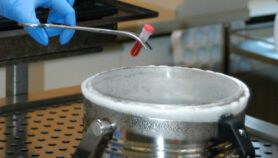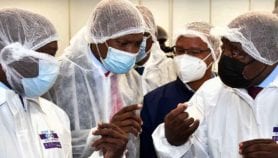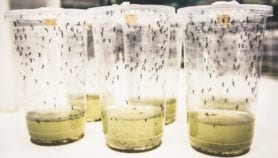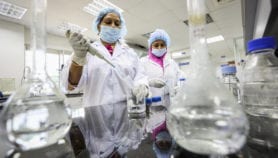Send to a friend
The details you provide on this page will not be used to send unsolicited email, and will not be sold to a 3rd party. See privacy policy.
A layered and cooperative approach would help Southern African countries harmonise their biosafety laws, says Julius Mugwagwa.
African countries have debated the pros and cons of modern biotechnologies for the best part of two decades. For Southern Africa, the debate changed fundamentally with the 2002–2003 food emergency. The region had faced food emergencies before, but this crisis posed an additional concern. Thousands of tonnes of food aid were thought to contain genetically modified (GM) maize.
The dilemma — use GM maize or face famine — revealed how unprepared individual countries (and the whole region) were for dealing with biosafety issues. It stimulated new efforts to develop national, and cross-national, regulatory regimes.
Some countries put interim measures in place. Malawi and Zimbabwe, for example, decided to distribute only milled grain. Zambia refused the grain outright.
Agriculture ministers from the Southern African Development Community (SADC) recommended creating an advisory committee to develop guidelines on GM organisms and broader biotechnology issues at a regional level.
Biosafety in numbers
A harmonised, or collective, regulatory biosafety system in Southern Africa is important for many reasons. In particular, geographical proximity and the inevitable spill-over effects of some biotechnologies mean countries must work together to solve problems. Shared policies could, for example, help national institutions prepare for the reality of GM products spreading across porous borders.
Cooperation would also help build economies of scale large enough to attract favourable technologies and products to the region, while creating a strong force to resist unwanted technology (for example where GM seed could threaten existing seed systems).
But a number of difficulties still loom large for the harmonisation agenda. International cooperation is difficult in any policy arena. The many actors are continually changing and ‘policy’ may mean different things to different people.
The fast-paced field of biotechnology is especially difficult. Even agreed policies can quickly stagnate as newer biotechnologies emerge.In Southern Africa, some policy actors remain skeptical, suggesting a regional biosafety agenda is a fad that will soon disappear.
Biosafety issues are also enmeshed within wide-ranging GM food issues, often with conflicting goals for trade and environmental management. And industrial giants, albeit a diminishing number, still dominate biotechnology and wield significant corporate power, while pressure groups can polarise debates.
A regional agenda would have to balance these conflicting pressures, as well as national interests (including sovereignty, institutional arrangements, relationships with external trading partners and economic groups, and interpretation of international law), against regional aspirations.
One size doesn‘t fit all
The region’s varying capacity for regulation further complicates things. For example, countries with advanced regulatory systems are unwilling to ‘step down’ to a regional framework, while others are reluctant to commit to seemingly unrealistic objectives.
The region also apparently lacks political will for a harmonised biotechnology agenda. Previous efforts, for example the 1990s’ Regional Biosafety Focal Point funded by the Dutch, and lately the AU Model Law on Safety in Biotechnology, have had limited success, leaving stakeholders reluctant to embark on new initiatives.
Some policymakers say pressures from international regulatory and technological targets, such as the AU Model Law, are rushing member states towards harmonisation when they would be better off developing incremental national or sub-national policies.
A last concern is that individual countries may lose out on funding if a regional technology management structure is established. Donors may prefer to support regional efforts rather than national programmes.
Cooperation from contribution
Given all this, establishing a harmonised cross-national biosafety framework for the SADC, where all countries face the same obligations, would be difficult and could spawn divisive tensions.
Far better, I believe, would be a multi-layered harmonisation or ‘convergence’ framework.
The layers would group countries by their development and use of biotechnologies. Layered regulatory systems would then impose appropriate obligations, guided by the regional position.
Problems could still arise — for example, if some countries prefer to only collaborate with more advanced nations than them. But the approach would allay fears of domination, promote ownership of regulatory processes and make ‘cooperation from contribution‘ more feasible. The layers could also provide useful benchmarks for measuring individual countries’ progress in developing and implementing biosafety systems.
Layering could also be issue-specific. The European Union, for example, issues regulations and directives on specific aspects related of GMOs, such as labelling, product release or risk assessment. A similar approach in Southern Africa could prioritise urgent matters, easing the pressures governments face from other policy arenas.
But whether biosafety regulation is regional or layered, supranational organisations such as the SADC, the African Union or the New Partnership for Africa’s Development, should clearly play a role in regional harmonisation — particularly by encouraging countries to learn from each other through sector-specific programmes and by helping individual countries implement new policies.
A coordinated approach that shares experience could strengthen weaker national and sub-national capacities and help develop and manage biotechnology.
Julius T. Mugwagwa is a researcher in the Development Policy and Practice/ESRC Innogen Centre at the Open University in the United Kingdom.













